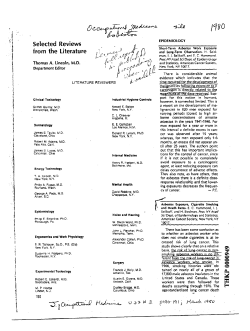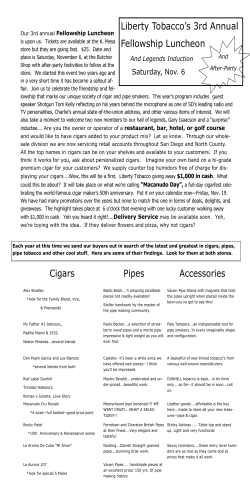
How to Remove Nonfriable Asbestos Cement Pipe
Asbestos Program How to Remove Nonfriable Asbestos Cement Pipe A Guide for Meeting DEQ Rules Purpose The Department of Environmental Quality (DEQ) regulates the removal, handling and disposal of asbestos-containing materials during construction, remodeling, and demolition. This document provides guidance for removing nonfriable asbestos cement (AC) pipe. Before you start Contact one of the DEQ regional offices (see contact information to the right) for information on complying with Oregon’s asbestos program regulations. Oregon Occupational Safety and Health Administration (OR-OSHA) also has rules for working with asbestos-containing materials. Contact OR-OSHA at 503-378-3272 for current rule and policy information. How to determine if a material contains asbestos The only way to determine if a material contains asbestos is to take a sample and have it analyzed by an accredited laboratory. What is asbestos cement pipe? Asbestos cement (AC) pipe was used widely in the mid-1900’s in potable water distribution systems and in sewer lines. Since the lifetime of this product is approximately 70 years, many projects to update this infrastructure involve removal of this product. The cement acts as a binder that holds the asbestos fibers within a solid matrix. This will prevent asbestos fibers from being released easily, unless mishandled, damaged, or in badly weathered condition. In most cases, AC pipe is considered nonfriable. Asbestos Program www.oregon.gov Contact Information: Clackamas, Clatsop, Columbia, Multnomah, Tillamook and Washington Counties, call the Northwest Region – Portland Office at 503229-5982, 503-229-5364 or 800-452-4011. Benton, Lincoln, Linn, Marion, Polk and Yamhill Counties, call the Western Region – Salem Office at 503-378-5086 or 800-3497677. Jackson, Josephine and Eastern Douglas Counties, call the Western Region – Medford Office at 541776-6107 or 877-823-3216. Coos, Curry and Western Douglas Counties, call the Western Region – Coos Bay Office at 541-2692721, ext. 222. Removing nonfriable AC pipe The removal of nonfriable asbestos-containing materials in good condition is exempt from some DEQ rules. You do not need to be a DEQ licensed asbestos contractor or a DEQ certified asbestos worker to do nonfriable asbestos removal. If you remove AC pipe following this guide, they should remain in a nonfriable condition. Crook, Deschutes, Harney, Hood River, Jefferson, Klamath, Lake, Sherman and Wasco Counties, call the Eastern Region – Bend Office at 541-633-2019 or 866-863-6668. Notification File a DEQ notification form ASN 6 for removal of nonfriable asbestos materials and pay the applicable fee. The notification must be received by the DEQ Business Office at least 5 days prior to starting the removal project. Baker, Gilliam, Grant, Malheur, Morrow, Umatilla, Union, Wallowa and Wheeler Counties, call the Eastern Region – Pendleton Office at 541278-4626 or 800-304-3513. Options for removing nonfriable AC pipe AC pipe must be removed, handled and disposed of in a manner that keeps the material in predominantly whole pieces to be considered nonfriable. Sanding, sawing, grinding, chipping, or the use of power tools is not allowed. The pipe must be kept wet during removal. Wetting minimizes asbestos fibers from being released. Lane County, call the Lane Regional Air Protection Agency at 541-736-1056. Last Updated: 3/31/14 DEQ recommends that you use the following methods to remove AC pipe. 1. Snap cutters Snap cutters (“squeeze-and-pop” equipment) operate by means of cutting wheels mounted in a chain wrapper around the pipe barrel. Hydraulic pressure, applied by means of a remote, pneumatically, or manually operated pump, squeezes the cutting wheels into the pipe wall until the cut is made. 2. Carbide-tipped blade cutters Blade cutters are frame adjustable to the circumference of the pipe and have a number of self-tracking rollers that align one or more carbide-tipped cutting blades. Because of the relatively low mechanical input and clean cutting action, hand operated blade cutters do not produce significant amounts of airborne asbestos dust. 3. Manual field lathes Manual field lathes are designed to end-trim and re-machine rough pipe barrels to factory-machined end profiles. The lathe consists of an adjustable, self-aligning arbor inserted into the pipe bore (which acts as a mandrel upon which the turning handle operates), a screw-fed turning frame, carbide machining blades, and manual (hand or ratchet) turning handles. 4. Wet tapping AC pressure pipe Pressure or “wet” tapping for service connections is performed in the trench while the pipe is under pressure. The equipment (manual driven) is affixed to the pipe by means of a chain yoke. A combination boring-and-inserting bar drills and taps the pipe wall and inserts a corporation stop or pipe plug. The pressure chamber, which protects against water leakage, also catches the asbestos-cement chips, so this is essentially a dust-free operation. 5. Dry tapping ACD pressure pipe Non-pressure or “dry” tapping for service connections may be performed in or out of the trench. The equipment is affixed to the pipe by means of a chain yoke. Separate drills and taps or a combination tool is used to drill and tap the pipe wall. Corporation stops or other connections may then be affixed to the pipe. 6. Manual rasp Short lengths of AC pipe, machined-end exclusively (MEE) and machined overall (MOA), can be cut to make closures and repairs and to locate fittings exactly. Field-cut ends may be re-beveled with a coarse wood rasp to form a taper approximating the profile of the factory-beveled end. 7. Chisel and rasp Holes may be cut into AC pipe with a hammer and chisel. The edge of a plumber’s wood chisel is used to cut completely around the hole outline, about ¼ in. (7 mm) from the prescribed line. The operation is repeated and the cut deepened until through. The edges of the hole are then dressed with a coarse wood rasp. 8. Hammer and chisel Replacement of damaged pipe may necessitate excavation, exposure and removal. AC coupling removal may be accomplished by gradually splitting the coupling lengthwise using a chisel and hammer. After the top of the coupling has been split, a crowbar or similar tool is used as a lever to split the bottom of the coupling. Waste Disposal Place the AC pipe in a leak-tight container and mark it with the warning statement “DANGER ASBESTOS-CONTAINING MATERIAL”. Locate a landfill that is authorized to accept asbestos waste and be sure to inquire about hours of operation and any special packaging requirements they might have. Fill out a DEQ waste shipment report ASN 4 and give it to the landfill upon arrival. If the material becomes friable If the AC pipe becomes shattered, damaged, or is badly weathered, it is considered friable and may release asbestos fibers. If the AC pipe becomes friable, stop work immediately and promptly contact a DEQ licensed asbestos abatement contractor. Friable asbestos materials must be removed by a DEQ licensed asbestos contractor using DEQ certified workers. All asbestos abatement rules under OAR 340-248-0005 through -0280 must be followed. A DEQ notification form ASN 1 for the removal of friable asbestos and the applicable fee must be filed. The notification must be received by the DEQ Business Office at least 10 days prior to starting the removal project. For emergency situations a waiver of the 10-day period may be granted by the DEQ. For more information contact DEQ. Alternative Formats Alternative formats of this document can be made available. Contact DEQ for more information at 503-229-5696.
© Copyright 2026













